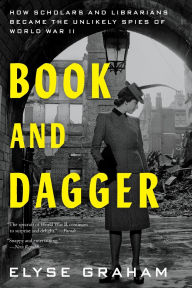Unlikely Agents: A Guest Post by Elyse Graham
Using letters, personal stories and declassified files, Elyse Graham highlights the brave efforts of the real-life academics-turned-spies who bravely challenged the Nazis during World War II. Read on for an exclusive essay from Elyse Graham on writing Book and Dagger.
Book and Dagger: How Scholars and Librarians Became the Unlikely Spies of World War II
Book and Dagger: How Scholars and Librarians Became the Unlikely Spies of World War II
By Elyse Graham
In Stock Online
Paperback $19.99
The untold story of the academics who became OSS spies, invented modern spycraft, and helped turn the tide of the war
The untold story of the academics who became OSS spies, invented modern spycraft, and helped turn the tide of the war
The call comes when you’re in a library. Or when you’re teaching in a college classroom; a man from the government shows up at the door in the middle of class. Or he comes to your office on campus, tells you things about yourself that your closest friends don’t know, and asks if you want to serve your country in a different way. Or the head of your department takes you aside and tells you, quietly, to go to the Yale Club tomorrow, wearing a purple tie. You’ll see a man smoking a cigarette; when he sees you, he’ll put it out. That man will have a message for you.
However it happens—you’ve been recruited to join the fight against Hitler as a spy. At the start of World War II, the United States didn’t have a standing intelligence agency, so William Donovan, who was told to build one in a hurry, marshaled brainpower by filling it with librarians and professors.
Many of them went on dangerous undercover missions abroad. Others worked as analysts in libraries and temporary plywood buildings all over Washington, solving problems in ingenious ways to produce tactical intelligence (what we do today) and strategic intelligence (what we do in the coming weeks and months). For the week before the Allies invaded North Africa, the OSS locked the analysts who helped to plan the invasion in the basement of the Library of Congress, so that nobody could kidnap them and pry loose their secrets.
As a historian, I was thrilled to have the opportunity to write the true story of these unlikely agents. The research took me all over the world, from a spy training school near London to the bazaars of Istanbul. And, of course, to all kinds of archives. I’ve met quite a few librarians who would make excellent spies, so perhaps it isn’t surprising that their bookish forbears rose to the occasion when they suddenly found themselves in a spy thriller. They didn’t just take on the Nazis and win; they came up with innovations that forever changed the world of intelligence. They represented America at its best.
If you’ve been in the basement of the Library of Congress, you know that it’s a warren of corridors upon corridors, a sprawling circumvolution of tunnels made of brick, made of concrete, made of drywall with steel pipes running overhead, made of a familiarly high-school combination of linoleum and flickering fluorescent lights, broken up by doors with intriguing labels like “Preservation Research & Testing Laboratory.” There’s plenty of space to lock a faculty of unlucky analysts down there for a week, or as long as it takes to win a major offensive using their research.
Walking around in that liminal place, I found it strangely easy to imagine turning a corner into some forgotten corridor and finding—wandering and looking for a way out—a few misplaced analysts from World War II: men and women in tweed, remarkably well-preserved thanks to the sterile archival air, having sustained themselves on forgotten lunch bags. They would take in my clothes and phone with surprise; I would explain how much time had passed, tell them the year.
“Did we win?” they would ask. “Or are we still fighting?”
“Yes,” I would say. “And yes.”

